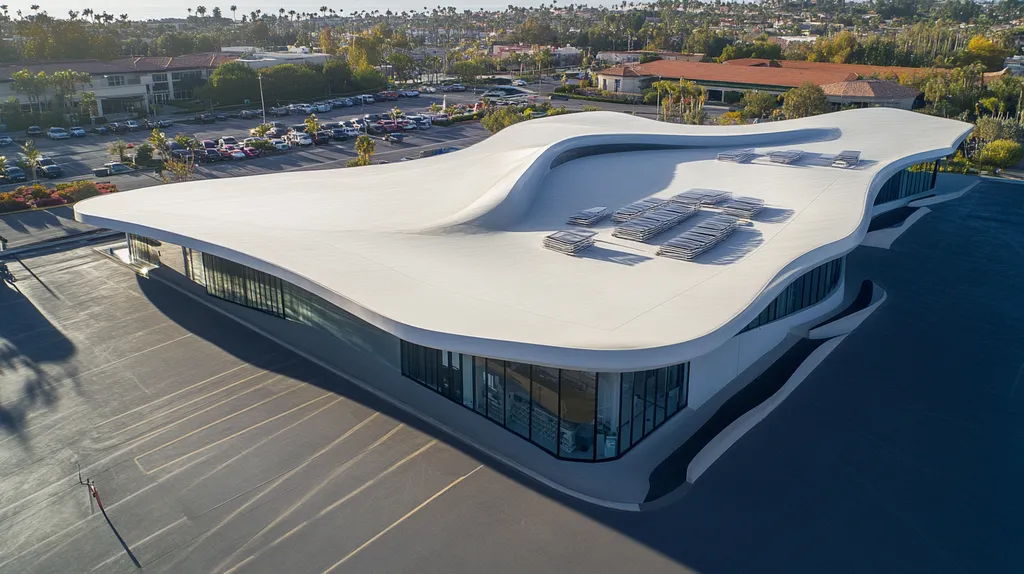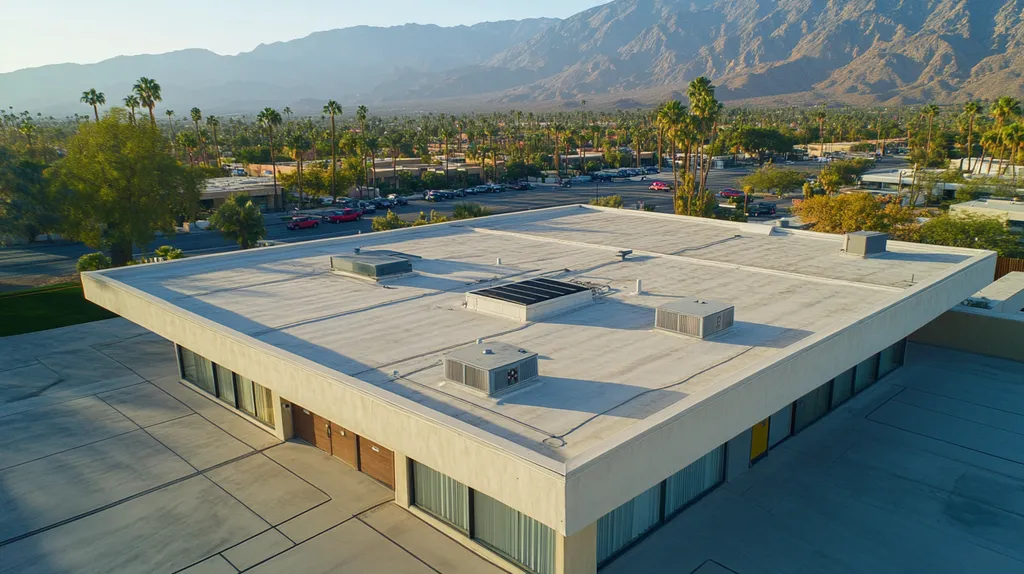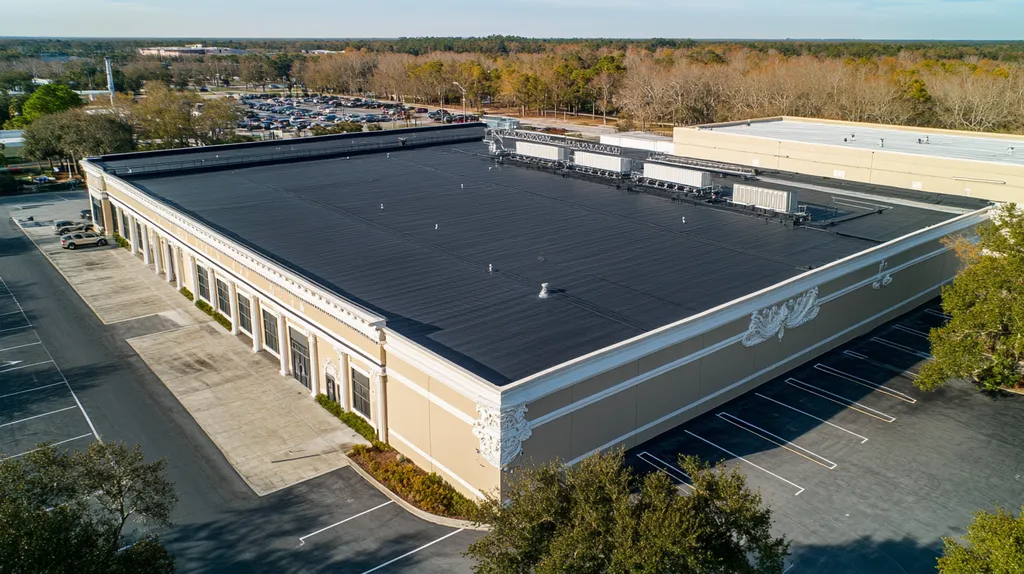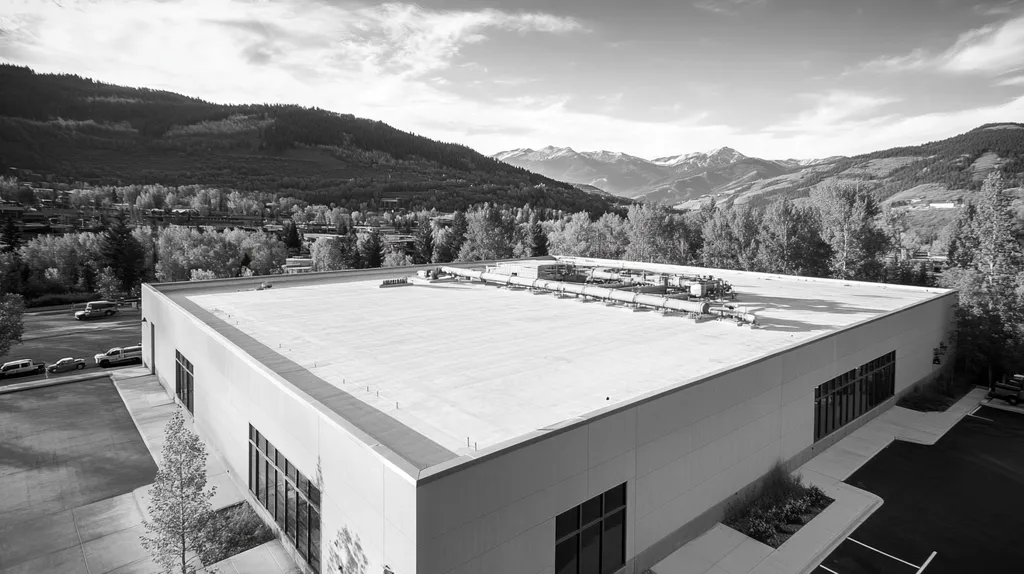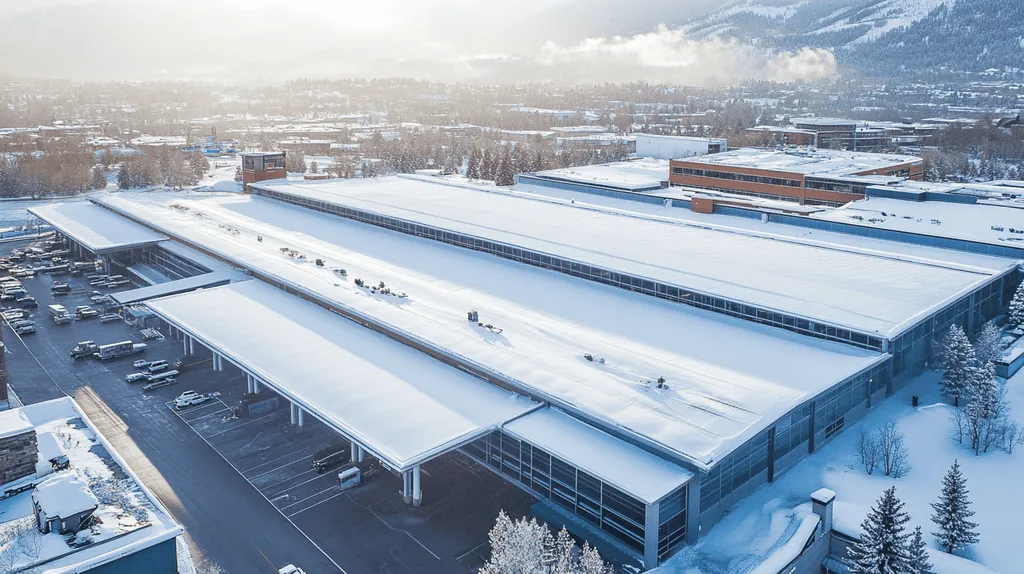In the world of industrial roofing, using the wrong coating tools can lead to catastrophic failures, with studies showing improper application causes up to 40% of roof coating failures. These mistakes cost facility owners millions in repairs annually.
From sprayers and rollers to specialized applicators, choosing the right tools can mean the difference between a roof that lasts decades and one that fails prematurely. Understanding these critical instruments isn’t just about protecting your investment—it’s about ensuring your facility’s long-term viability.
This comprehensive guide breaks down the essential tools, techniques, and terminology needed for successful industrial roof coating applications, helping property managers make informed decisions that maximize their roofing investment.
SECTION 1: THE BASICS EXPLAINED
Coating an industrial roof is not just a routine job; it’s a vital investment that enhances your building’s durability and efficiency. A well-coated roof can cut energy costs by up to 30%, safeguard against leaks, and significantly prolong the roof’s life. With such striking benefits on the table, it’s crucial for property owners and facility managers to familiarize themselves with the tools involved in applying these coatings.
What It Is (In Plain Language)
An industrial roof coating is a liquid layer applied to the roof’s surface, which cures to create a robust protective barrier. This coating serves multiple purposes, including waterproofing, offering UV resistance, and boosting energy efficiency. In simple terms, it acts as a guardian against the elements while enhancing the roof’s overall performance.
There are various types of coatings available, such as elastomeric, polyurethane, and silicone-based products. Each of these options boasts unique benefits tailored to specific roofing materials and conditions. Recognizing these differences is essential when choosing the right coating for your facility.
The tools used for applying these coatings can range from rollers and brushes to spray equipment. Each tool has a specific method of application, which can greatly influence the final quality and longevity of the coating. Knowing the right tool for the job is vital for ensuring an effective application process.
By successfully applying a roof coating, buildings gain protection and contribute to overall sustainability and energy efficiency. As energy prices soar and environmental concerns escalate, choosing the right coatings has never been more important.
Why It Matters (To Your Building)
Selecting the right roof coating carries both immediate and long-term benefits for any facility. A quality coating can significantly extend a roof’s lifespan, often surpassing uncoated systems by several years. For industrial structures, this means lower maintenance costs and minimal interruptions to operations.
A well-coated roof also boosts energy efficiency by reflecting solar heat, resulting in lower cooling expenses. Saving 30% on energy bills can have a substantial positive effect on the finances of large industrial properties. This positioning makes roof coatings a smart financial move toward sustainable operations.
On the flip side, neglecting to apply roof coatings can lead to serious issues down the line, like leaks, structural damage, and even mold growth. These problems extend beyond the roof and can jeopardize the entire integrity and safety of the building. Therefore, applying roof coatings proactively should be a top priority.
By understanding the impact of roof coatings, property owners can take decisive action before issues arise. Recognizing a coated roof as a crucial element of building maintenance helps facility managers stay vigilant in their upkeep efforts.
How It Works
Roof coatings operate through a blend of chemical principles and effective application techniques. When applied properly, these coatings bond to the roof substrate, creating a continuous layer that is both flexible and long-lasting. This bond ensures protection against rain, UV radiation, and temperature changes.
The durability of a coating largely hinges on thorough surface preparation and the method used for application. For example, spraying can yield a consistent application and minimize missed areas, but demands skilled technicians. Rollers and brushes provide a more hands-on approach, yet inconsistent coverage may result without careful attention.
Temperature and humidity levels also significantly influence how well a coating adheres and performs. Optimal environmental conditions ensure maximum effectiveness. Therefore, it’s essential for facility managers to check these factors before scheduling coating applications.
Lastly, regular inspections and maintenance post-application can prolong the life of the coating. Understanding the coating’s lifecycle and the roof system enables property owners to make informed decisions that protect their investment.
SECTION 2: PRACTICAL APPLICATIONS
Understanding how to effectively use coating tools can make a world of difference for industrial roofs. Proper application not only enhances durability but also boosts energy efficiency, addressing both financial and environmental concerns. Remarkably, facilities that proactively coat their roofs can experience energy cost reductions of up to 30%. In this section, we will delve into common uses for coatings, the optimal timing for application, and how these coatings interact with existing roofing systems.
Common Uses & Examples
Coating tools in industrial roofing serve vital functions that can transform a roof’s performance. One key use is waterproofing, critical for preventing leaks and damage. For example, elastomeric coatings seamlessly applied to metal or modified bitumen roofs create an effective barrier against water intrusion, ensuring that rainwater stays where it belongs—outside.
Another essential application is UV protection. Coatings with UV-reflective properties are lifesavers for building roofs. In large facilities, such as warehouses, these coatings significantly reduce rooftop temperatures, thereby improving energy efficiency and cutting cooling costs.
Moreover, coatings can extend the life of existing roofing materials. Many property owners choose to apply roof coatings even when no immediate issues are visible. This preventative approach can add up to 10 years of life to single-ply and built-up roofing systems, maximizing their value.
Recognizing these common applications empowers facility managers to make informed decisions about which coating tools to invest in, ensuring their roofs receive long-lasting benefits.
When You Need It Most
Timing matters significantly when it comes to coating applications. It’s advisable to coat roofs before facing severe weather conditions. For instance, applying a coating in late spring prepares the roof for upcoming humid summer months, reducing damage from intense heat and moisture.
Additionally, coatings are crucial after any substantial repair work. If a section of the roof has been patched, adding a coating can seal the repaired area and provide essential additional protection. Skipping this step can lead to moisture issues in those vulnerable spots.
Regular inspections also indicate when coatings are needed. If frequent leaks or signs of wear are noticed, it’s time to refresh the roof coating. Promptly addressing these signs can safeguard against severe problems down the line.
Awareness of these critical timing considerations can enhance the longevity and effectiveness of industrial roofing systems, ultimately saving money and headaches.
Interactions With Other Systems
Coating tools do not operate in isolation; they must work in harmony with existing roofing systems and other building components. For example, effective drainage systems significantly influence a coating’s performance. When a roof drains properly, coatings dry thoroughly, which increases their effectiveness against water intrusion.
Choosing the right coating tool also involves ensuring compatibility with insulation materials. Some coatings can react adversely with foam insulation, leading to degradation that reduces effectiveness over time. Consulting with specialists helps ensure that the selected coatings align with a facility’s other systems.
Moreover, energy-efficient roofs that incorporate coatings can seamlessly integrate with solar panel systems. Coatings designed for high reflectivity can improve solar installations’ efficiency by reducing heat absorption on the roof surface.
Recognizing these interactions allows facility managers to make comprehensive, informed choices, ultimately bolstering the performance, efficiency, and lifespan of their roofing investments.
SECTION 3: KEY TERMINOLOGY DECODED
Understanding the lingo surrounding roofing coatings is more than just academic; it’s essential for effective applications that protect your investment. Misunderstandings can lead to severe mistakes, potentially costing businesses both time and money in repairs. By grasping these vital terms, property owners and facility managers can engage meaningfully with roofing professionals, empowering them to make informed choices that enhance their roofs’ longevity and performance.
Essential Terms Explained
One of the most common terms encountered in the world of coatings is “elastomeric.” This flexible coating can stretch and contract without losing its grip, making it ideal for roofs that endure extreme temperature changes. Think of it as a super stretchy rubber band keeping the roof’s surface intact.
Next up is “reflectivity,” a critical concept that measures how effectively a coating can bounce back sunlight. A high reflectivity rating means less heat is absorbed, keeping your building cooler and slashing energy costs.
“Substrate” is another term you’ll frequently encounter. This word refers to the surface on which the coating goes. Different substrates, like metal or concrete, require specific coatings tailored for optimal adhesion and performance. The right match here is crucial for ensuring the durability of the coating.
Lastly, the acronym “VOC” stands for Volatile Organic Compounds. These are chemicals released during the application of certain coatings, which can affect air quality. Being aware of VOC levels is important for adhering to environmental standards and maintaining a safe workplace.
Industry Jargon Translated
Industry jargon can often confuse even the most seasoned professionals. For instance, “low slope” versus “steep slope” roofs refers to the roof’s angle, each requiring unique coating considerations. Low slope roofs need special attention to drainage to ensure long-lasting durability.
The term “adhesion” is pivotal; it describes how well a coating sticks to its substrate. Strong adhesion is essential for a coating’s effectiveness; without it, coatings may peel off, ultimately leading to unnecessary repairs.
Another term to be on the lookout for is “retrofit.” This refers to applying a new coating over an existing roof rather than doing a complete replacement. This method can be efficient and cost-effective, but understanding the existing roof system is crucial to ensure compatibility.
Lastly, “thermal performance” relates to how well a roofing system maintains energy efficiency. Improved thermal performance means better temperature control, which can lead to significant savings on heating and cooling bills for buildings.
Measurement & Units Simplified
When it comes to coating applications, accurate measurements matter immensely. Take “mil,” for example—this unit measures one-thousandth of an inch and is often used to specify the thickness of coatings. Grasping this measurement ensures the coating is applied at the correct thickness for maximum effect.
“Square footage” is another key measurement you need to know. This term defines the area of the roof that requires coating. Calculating square footage accurately ensures that you purchase enough materials, preventing delays or unexpected costs.
Additionally, “dry film thickness” (DFT) measures how thick the coating is after it dries. This measurement is crucial for confirming that the coating performs as intended, with specific DFT levels required for optimal results.
Finally, understanding the “coverage rate” is vital. This term tells you how much area a specified volume of coating can cover, usually expressed in square feet. Knowing this helps accurately estimate how much product to order, making the entire application process smoother and more efficient.
SECTION 4: DECISION FACTORS
Selecting the right tools for applying coatings to an industrial roof is a decision that shouldn’t be taken lightly. With the wrong choices, property owners may face significant risks, including leaks that wreak havoc on roofing structures and costly repairs to underlying assets. This section delves into critical decision factors such as cost considerations, performance trade-offs, and lifespan and durability factors, all designed to empower property owners in making savvy choices.
Cost Considerations
Cost is a leading factor when weighing options for coating tools. Prices vary significantly, impacting both initial budgets and long-term maintenance expenses. A lower-cost roller might seem like a bargain at first but could result in higher labor costs due to inefficiencies, necessitating more frequent applications to reach desired results.
Quality tools may demand a steeper initial investment, yet they often pay for themselves by streamlining the application process. Consider pneumatic sprayers, for instance; they apply coatings faster and more uniformly than traditional brushes or rollers, enhancing overall workflow efficiency.
It’s crucial to look beyond the sticker price. Ignoring the potential for future repair costs stemming from poor application can lead to financial setbacks. Evaluating both the tool costs and their long-term impact on roof performance is essential for making wise investments.
Ultimately, investing in the right tools can save facilities from complications down the line. A slightly higher upfront expenditure for reliable equipment can prevent expensive damage and repairs, giving property owners peace of mind in their roofing ventures.
Performance Trade-offs
Every tool comes with its unique strengths and weaknesses that can affect the performance of a roof coating. Spray applications, for instance, provide an even coat but require skilled operators to prevent overspray, which can waste material and potentially damage nearby surfaces.
Brushes and rollers, on the other hand, allow for more precise control, making them ideal for intricate areas. However, they may not cover as well as sprays, which can lead to the need for more frequent applications—potentially increasing labor costs.
These performance trade-offs can also affect not just aesthetics but also the durability of the coating. A tool that delivers exceptional coverage may enhance operational efficiency, while simpler options could jeopardize the coating’s lifecycle.
Facility managers must carefully balance these trade-offs, considering how their tool choices align with specific roofing needs, boundaries, and environmental conditions. Informed decisions in this area can go a long way in optimizing coating performance.
Lifespan & Durability Factors
The tools used for applying coatings play an essential role in determining their lifespan and durability. High-quality applicators that facilitate precise application contribute to a strong seal against weather elements. On the contrary, poor application can lead to premature coating failures, resulting in costly replacements.
Environmental factors also play a critical role in application effectiveness. Applying coatings under inappropriate temperature or humidity conditions can lead to adhesion problems. Advanced tools designed for precision application can help mitigate such issues.
Moreover, it’s vital to consider how different tools influence the bonding process throughout the coating’s life. Equipment that guarantees a uniform thickness will significantly enhance the long-term reliability of the roof system.
In conclusion, choosing the right tools is vital for maximizing the lifespan and durability of roofing coatings. A thoughtful approach ensures that property owners invest in effective solutions and enjoy long-term benefits for their industrial roofs.
SECTION 5: COMMON CHALLENGES
Applying coatings to industrial roofs is not just a step in a maintenance checklist; it’s a potential minefield of challenges that can lead to expensive repairs and a shorter roof lifespan. Research shows that 40% of roofing failures stem from improper application methods, underscoring the need for vigilance. Realizing common hurdles and addressing them head-on is crucial for property owners and facility managers eager to secure long-term, reliable roofing solutions.
Frequent Problems & Solutions
One prevalent challenge during the application of roof coatings is surface contamination. Dirt, oil, and remnants of old roofing materials can prevent coatings from bonding effectively. To tackle this, a thorough cleaning using power washers and specialized cleaners is essential, ensuring a clean canvas for optimal adhesion.
Another pitfall is applying the wrong type of coating for your roof’s material. For instance, silicone coatings aren’t compatible with every substrate, which may lead to adhesion failures. Property managers should always consult product specifications to guarantee compatibility, securing the best performance from their chosen coating.
Weather plays a significant role as well. Coating applications under extreme temperature conditions can affect adhesion and curing times, leading to complications down the line. Keeping an eye on weather forecasts and planning applications accordingly can save time, money, and headaches.
Last but not least, the skill level of personnel matters tremendously. Inexperienced applicators can introduce errors in technique, leading to subpar results. To combat this, relying on seasoned contractors and ensuring they receive proper training for the specific coating product will greatly mitigate potential mistakes.
Warning Signs To Watch For
Catching warning signs early can save facility managers from extensive damage and the burden of costly roof replacements. Look out for bubbling or blistering, which often indicates poor adhesion due to trapped moisture. Regular inspections are key to spotting these issues before they evolve into serious concerns.
Another red flag is noticeable discoloration. This change can signal UV degradation or chemical reactions affecting the coating’s integrity. Frequent visual checks can identify these changes, allowing for swift corrective actions before significant deterioration occurs.
Additionally, cracks in the coating can suggest structural movement or inadequate application thickness. Routine inspections should include a trained eye for hairline fractures to ensure they’re caught early, preventing bigger repairs in the future.
Finally, pooling water on the roof surface is a critical sign that drainage is compromised. Addressing drainage concerns promptly is vital to maintain the integrity of both the coatings and the underlying roofing materials.
Preventative Approaches
Proactive measures can substantially reduce the likelihood of common coating challenges. Implementing a routine inspection schedule helps identify potential issues before they escalate, allowing for timely remediation. Regular assessments by roofing professionals ensure that all aspects of the roof receive thorough scrutiny.
Before applying any coatings, rigorous surface preparation should be prioritized. This means removing dust, debris, and any contaminants that could hinder adhesion and performance.
Using high-quality, manufacturer-recommended products can also protect against common pitfalls. Manufacturers often provide extensive support to help users select the right coatings, tailored for specific roofing materials and environmental conditions.
Lastly, educating facility staff on routine maintenance can empower them to quickly spot emerging issues. Training programs can teach them what to look for and when to enlist professional help, ensuring your roof remains in excellent condition for years to come.
SECTION 6: NEXT STEPS & RESOURCES
Taking the right steps toward coating applications is crucial for ensuring the longevity of industrial roofs. Property owners and facility managers should arm themselves with the right questions for potential providers, ensuring they receive quality service. Understanding industry standards and seeking educational resources can further strengthen your decision-making process. This section outlines essential considerations and tools for effective coatings on industrial roofs.
Questions To Ask Providers
When evaluating a roofing provider, asking the right questions can make all the difference. Start by probing their experience with your chosen type of coating. Can they share specifics about past projects that reflect their expertise? This knowledge can foster confidence in their abilities.
Next, inquire about the materials they utilize. Are they compliant with industry standards? Using high-quality materials directly impacts adhesion and longevity, critical factors for protecting your investment. Don’t forget to ask about warranties, covering both the materials and workmanship to ensure peace of mind.
Understanding their application techniques is also essential. Are they equipped with up-to-date tools and methods? The effectiveness of the coating hinges on these factors. Finally, request references or case studies demonstrating their prior successful projects, offering you a glimpse into their reliability.
Industry Standards & Guidelines
Adhering to industry standards is integral to the performance and durability of roof coatings. Entities such as the American National Standards Institute (ANSI) provide essential guidelines for various applications. Familiarizing yourself with these standards allows you to gauge the quality of services that roofing providers offer.
Additionally, the National Roofing Contractors Association (NRCA) publishes best practice guidelines outlining installation procedures and suitable materials for different environments. Staying informed about these specifications can elevate your decision-making process when selecting a service provider.
Keeping current with industry developments is equally crucial. Regularly browsing publications and attending workshops can expand your knowledge of new standards and innovations in coating technologies, hence boosting your confidence in making informed choices.
Further Learning Simplified
For those looking to deepen their understanding of roofing coatings, a wealth of resources is readily available. Online courses and webinars can provide structured learning experiences about application methods and material selection tailored for industrial roofs.
Joining industry associations can be a game-changer as well. Membership often grants access to valuable educational materials, networking opportunities, and the latest regulatory updates. Interacting with fellow professionals cultivates an environment rich in shared knowledge and best practices.
Finally, reputable manufacturers frequently offer instructional resources and guides specific to their products. Tapping into these valuable materials can illuminate the application process and potential challenges, significantly enhancing your proficiency in managing roofing projects.
The Bottom Line
With 40% of roof coating failures stemming from improper tool selection and application methods, the stakes couldn’t be higher for industrial property owners.
The right coating tools, properly utilized, can extend a roof’s lifespan by decades while cutting energy costs by up to 30%.
From sprayers that ensure even coverage to rollers designed for detailed work, each tool serves a specific purpose in protecting your facility’s most vital asset.
By understanding these essential tools, following industry standards, and working with qualified professionals, facility managers can avoid costly failures and maximize their roofing investment.
The future of industrial roofing lies in smart coating choices – making informed decisions today safeguards your facility for tomorrow.
FREQUENTLY ASKED QUESTIONS
Q. What is an industrial roof coating?
A. An industrial roof coating is a liquid protective layer applied to roofs. It enhances roofs’ durability, waterproofs, and offers UV resistance, acting as a guardian against the elements while boosting performance.
Q. How do coating tools boost energy efficiency for commercial roofs?
A. Coating tools apply materials that reflect heat, significantly lowering rooftop temperatures. This reduction leads to decreased cooling costs, with facilities enjoying up to 30% savings on energy bills.
Q. What are important terms related to commercial roof coatings?
A. Key terms include “elastomeric,” which describes flexible coatings; “reflectivity,” measuring sunlight bouncing ability; and “substrate,” indicating the surface the coating adheres to. Understanding these is crucial for effective applications.
Q. How can I choose the right tools for an industrial roof?
A. Consider factors like cost, performance, and durability. Higher-quality tools may have a higher upfront cost but yield better results, extending the lifespan of the coating and reducing maintenance needs.
Q. What common challenges exist during coating applications for industrial roofs?
A. Frequent challenges include surface contamination, incorrect coating types, and weather extremes affecting adhesion. Proper preparation, product knowledge, and timeliness can help mitigate these issues for successful applications.
Q. What questions should I ask my coating provider for a commercial roof?
A. Ask about their experience with specific coatings, the quality of materials used, industry compliance, application techniques, and references. These questions ensure you’re hiring a knowledgeable and reliable contractor.
Q. How do environmental conditions impact industrial roof coatings?
A. Temperature and humidity affect adhesion and curing times. Applying coatings in optimal conditions enhances performance, while neglecting these factors can cause problems such as peeling or improper curing, resulting in costly repairs.


